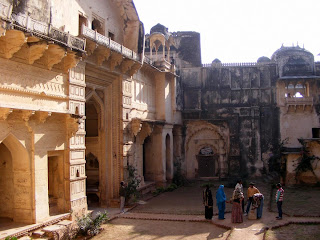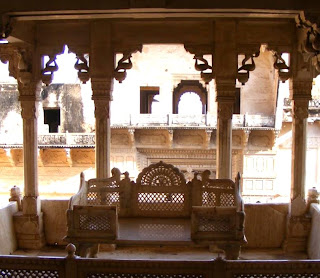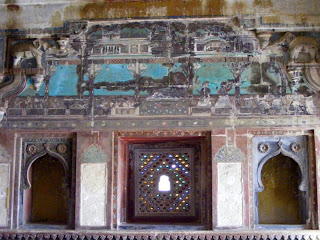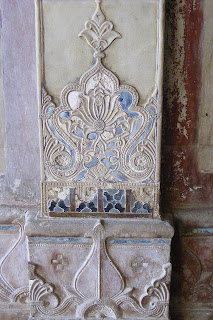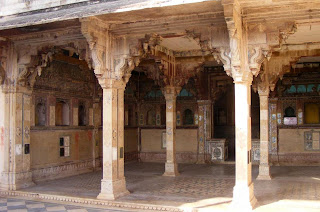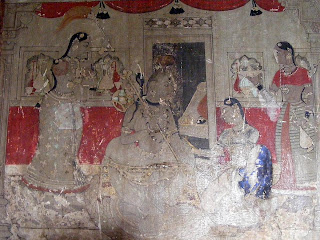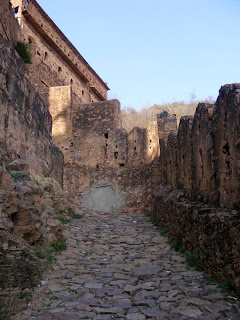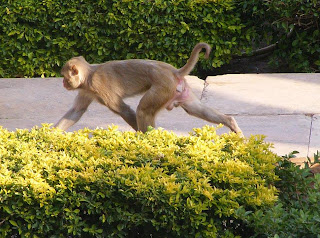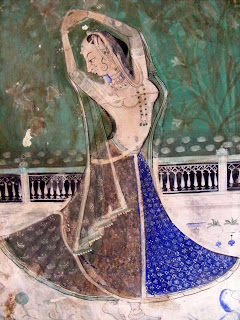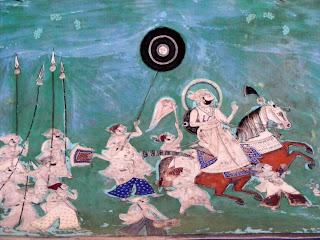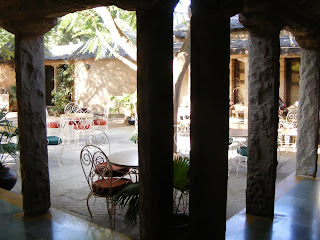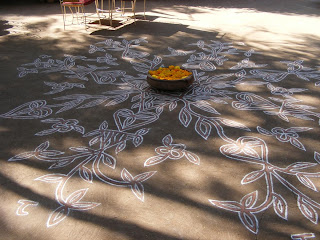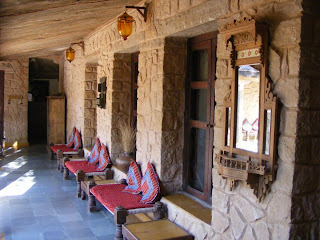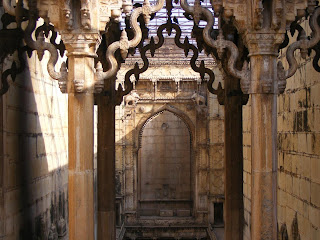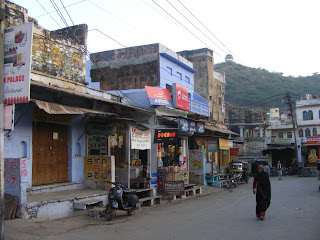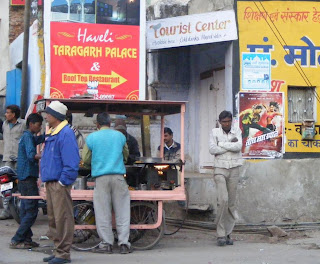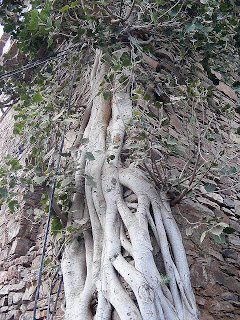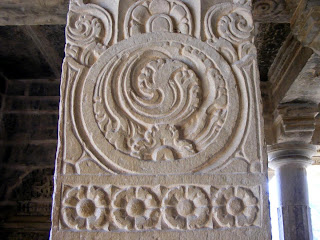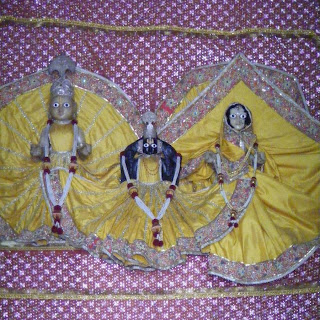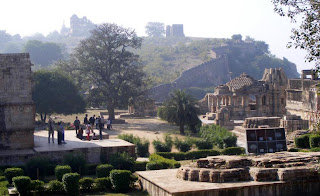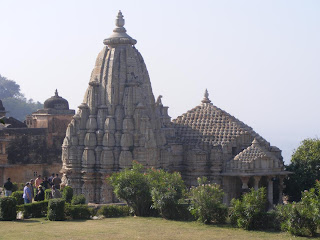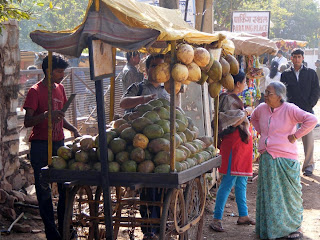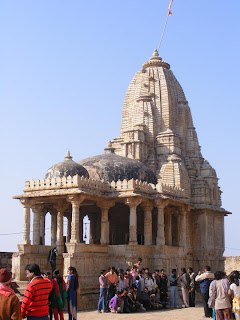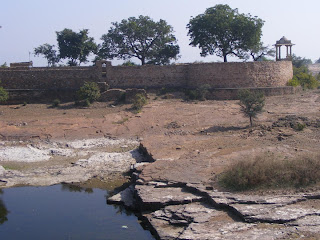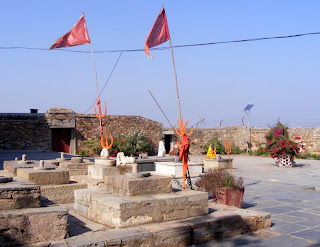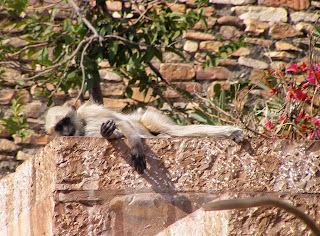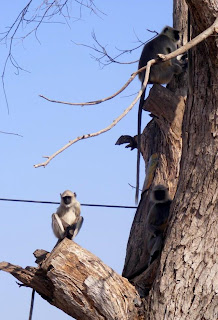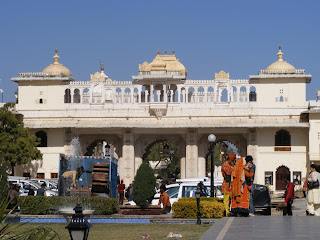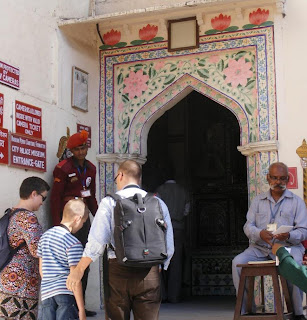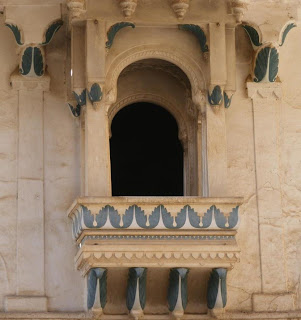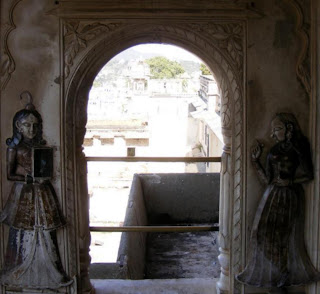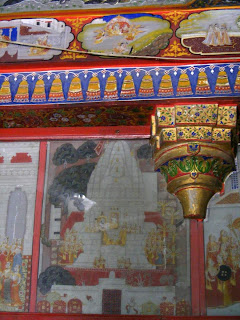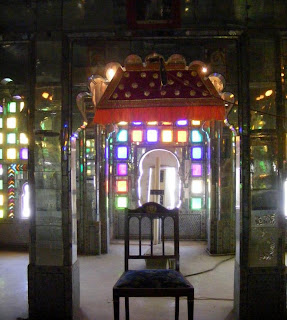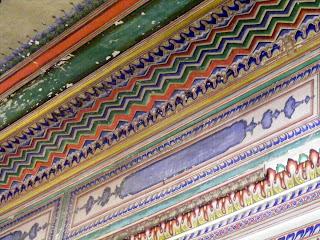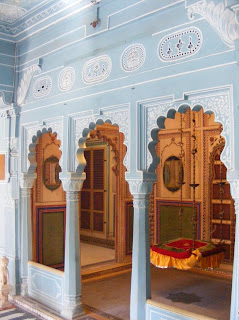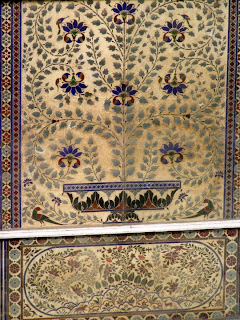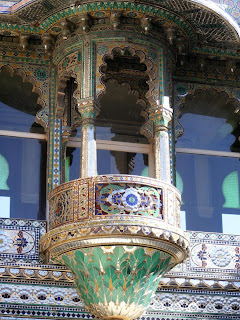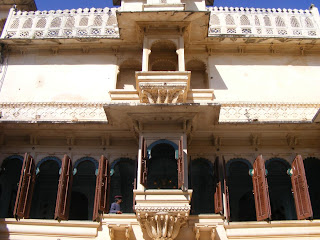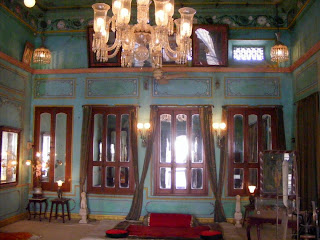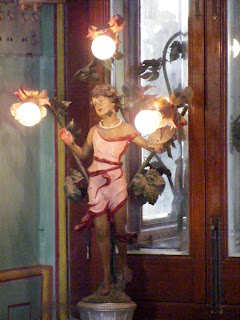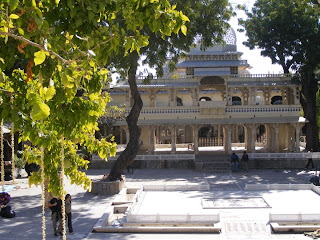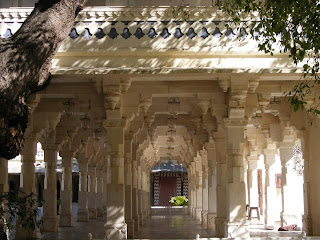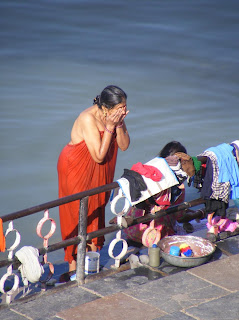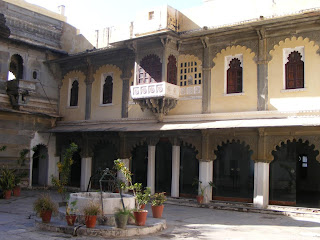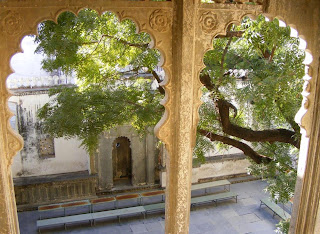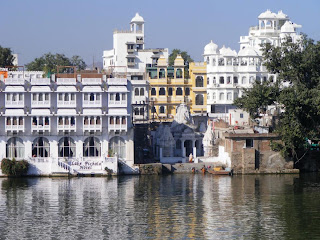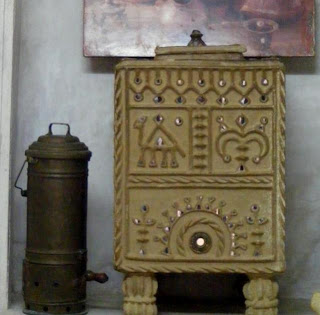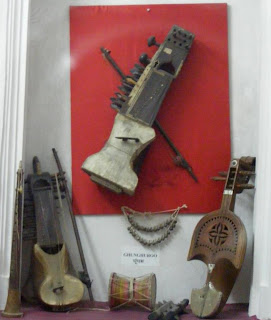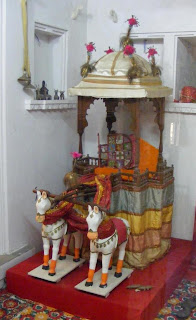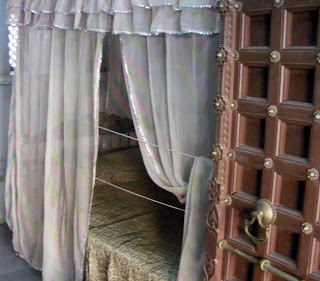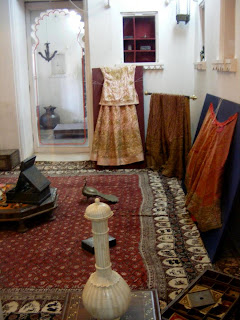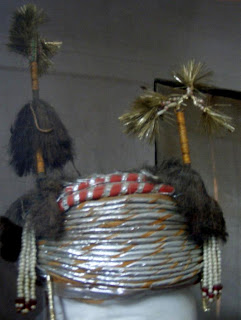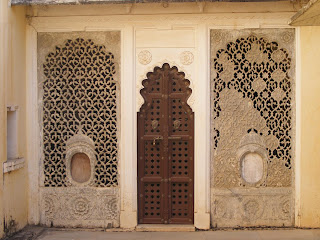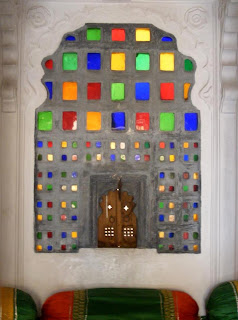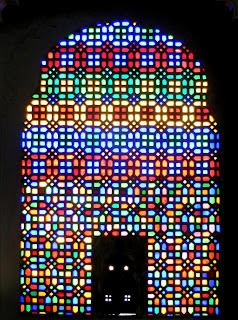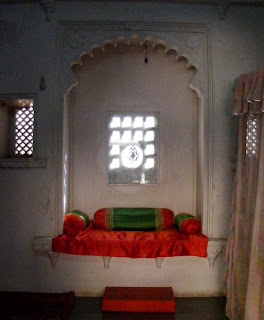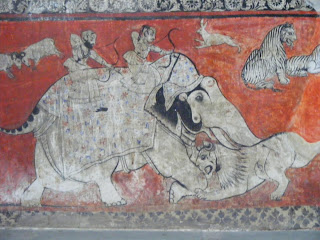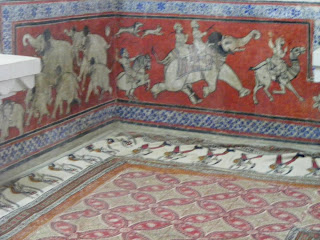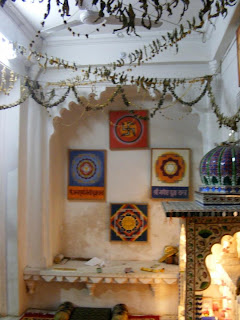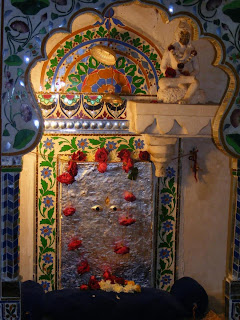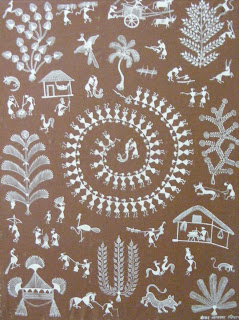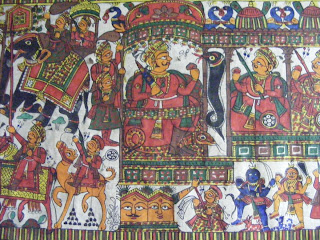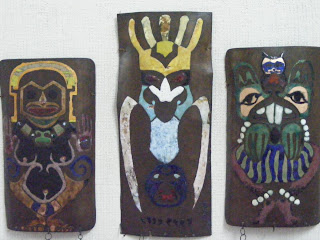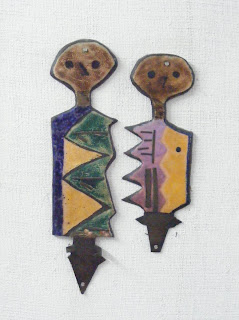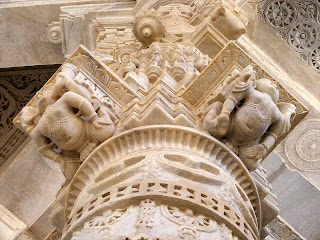Below the fort, the Palace of Bundi, in fact more little palaces: Chhatra Mahal, Phool Mahal, Badal Mahal and Chitrasala or Sheesh Mahal, awaits the visitors with art treasures. But beside 3 young Indians, we have been the only visitors. The entrance ticket is 100 Rp/ person and 50 Rp are for one camera.
The Hathi Phol is a magnificent gate, erected in 1607. Bundi Palace is still the property of the Maharaja of Bundi. Not so far ago, it was a deserted place but the Maharaja hired a company to clean the palace, which was a bats’ hole, and then opened it for the public.
At the first floor, we saw the white marble throne and the first murals. Then, we climbed to the second floor, where the Chhatra Mahal, erected in 1644, presented us with the first murals. The terrace offers nice view offer the town and the Nawal Sagar lake.
The next level represented the Phool Mahal, erected in 1907. The most important painting there represents a royal procession.
Then we visited Badal Mahal or the Clouds Palace. Every inch of wall is covered with paintings. The most common motifs are the peacock (national bird) and Lord Krishna. It’s pretty dark in the room, like everywhere in the palace. The painting is deteriorated in many places. It is a pity that such a valuable art may be lost. The international crisis and the fact that so few foreigner tourists are coming here, in Bundi, does not help either.
We left the palace through Hathi Phol and went to Chitrasala or Sheesh Mahal, a palace built in the XVIII-th century. The entrance is included in the ticket. There are many monkeys here. Right at the entrance, I shoot a photo of one, looking over the valley. Abruptly he or she run furiously toward me, trying to attack. Lucky that my husband had a stick which taught her/him respect!
In Chitrasaa we found first a nice garden courtyard, with a small altar and…more monkeys. I was already afraid of them…The kind guardian opened the door of the terrace for us. He keeps it locked because of the monkeys. He also told us that the royal family comes here very often, sitting in the garden and looking over the town, while they drink coffee or tea.
Sheesh Mahal has a lot of mural paintings too. The background is usually vernil (a shadow of green). The main themes are: music and dancing, the court life but we also see Ganesh or Krishna dancing or singing to the flute, after he stole some maids’ dresses.
I left with regrets this beautiful place, one of my favourite in Rajahsthan. Jaipur, the Pink City awaits us!
Vizibil din tot orasul, Fortul Taragarh sau Fortul Stea, numit astfel din cauza formei sale, a fost construit in 1354 de catre Rao Bar Sngh. Pana la el poti urca pe un drum abrupt, prin vegetatia salbaticita si feirndu-te de maimutele cam agresive aici. Intrarea este libera. Cand am fost noi in Bundi, nu am vazut insa pe nimeni urcand acolo.
Palatul din Bundi, de fapt mai multe palate mai mici: Chhatra Mahal, Phool Mahal si Badal Mahal, se afla mai jos, pe acelasi deal. El este inca proprietatea Maharajei din Bundi. Dupa ani de stat in paragina, l-a dat in grija unei companii care l-a curatat si apoi l-a deschis pentru public. Poate de aceea zidurile sale sunt inca innegrite si aspectul general nu este unul de ingrijit si vizitat intens ca la Udaipur, de exemplu. Acesta pare inca, oarecum, salbatic. In afara de noi si de paznici, drumul nostru s-a mai intersectat cu un grup de 3 tineri indieni si….atat!
Dupa ce iti cumperi bilet ( 100 Rp/persoana + 50 Rp pentru fotografiat), urci domol pe o strada pietruita, ridicandu-te deasupra orasului. In fata, ai privelistea zidului fortului si a unui mic templu, iar jos, in urma, se vede orasul.
In curtea principala se intra prin Poarta cu Elefanti sau Hathia Phol, construita in 1607, trecand prin holul cu elefanti.
Urcam la etaj si ne aflam intr-o galerie acoperita, sprijinita pe stalpi de piatra. La marginea sa, un tron din marmora alba, de unde perechea regala putea urmari ceremoniile din curte. In cele doua incaperi intunecate, incep sa ni se infatiseze miniaturile pictate pe pereti, care fac faima palatului.
La etajul superior, unde ne conduce o scara ingusta, iesim pe o terasa. Din nou, o priveliste minunata spre oras si spre lacul Nawal Sagar. Aici se afla un mic bazin, in care odinioara susura apa.
Stalpi cu elefanti sprijina tavanul terasei de la Chhatra Mahal, construit in 1644. Pardoseala de mosaic si stalpii cu oglinzi si faianta confera spatiului, eleganta. Si aici, o suita de picturi murale, reprezentandu-l, mai ales, pe Krishna.
Tematica picturilor de aici este bogata: povesti de dragoste, viata la curte, dansul si muzica. Fondul multor picturi este vernil. Il vedem pe Ganesh, pe Krishna, care danseaza sau canta la flaut ucat intr-un copac, dupa ce a furat hainele unor fete.
Palatul din Bundi si Chitrasala reprezinta unul dintre locurile care mi-a placut cel mai mult in Rajahstan. Pacat ca aproape peste tot, cu exceptia Fortului Mehrangarh din Jodhpur unde am avut un excelent audio-ghid si a Fortului din Jaisalmer, unde Prashar a fost de asemenea un ghid de exceptie, nu am beneficiat de ghizi locali. Cei care se invarteau pe langa casele de bilete si isi ofereau serviciile nu faceau impresia unor ghizi autentici. De altfel, la Pokaran am avut un astfel de ghid care ne spunea efectiv ce vedeam, fara a ne da vreo explicatie si care ne-a costat 50 Rp pentru nimic! A trebuit sa ma bazez pe documentarea proprie, facuta pe internet si din Lonely Planet, care sunt totusi sumare si, mai ales, seci, fara acele povesti pe care ti le poate spune un ghid.
Ne despartim cu parere de rau de Palatul din Bundi si ne indreptam spre hotel. Maine ne asteapta Jaipurul, Orasul roz, cu alte comori de basm.









